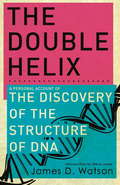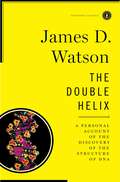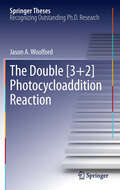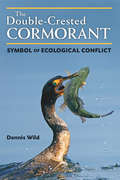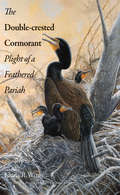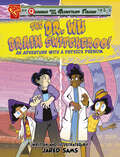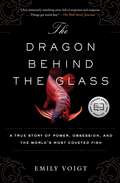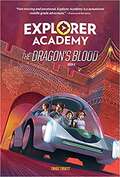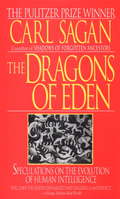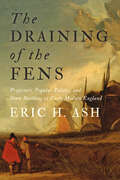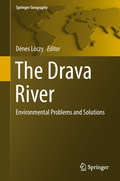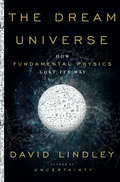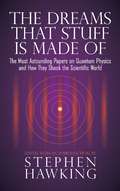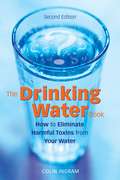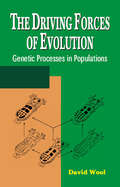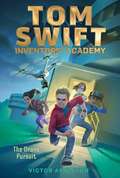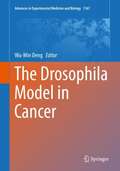- Table View
- List View
The Double Edged Helix: Social Implications of Genetics in a Diverse Society
by Adrienne Asch Jon Beckwith Peter Conrad Lisa N. Geller Joseph Alper Catherine ArdThe authors address the medical and ethical implications of the new technologies, outlining potential positive and negative effects of genetic research on minorities, people with disabilities, and those of diverse sexual orientations. Presenting a wide array of perspectives, this book emphasizes the need to ensure that research into genetics does not result in discrimination against people on the basis of their DNA.
The Double Helix: A Personal Account Of The Discovery Of The Structure Of Dna (Critical Editions Ser. #0)
by Dr James WatsonThe story of the most significant biological breakthrough of the century - the discovery of the structure of DNA.'It is a strange model and embodies several unusual features. However, since DNA is an unusual substance, we are not hesitant in being bold' By elucidating the structure of DNA, the molecule underlying all life, Francis Crick and James Watson revolutionised biochemistry. At the time, Watson was only 24. His uncompromisingly honest account of those heady days lifts the lid on the real world of great scientists, with their very human faults and foibles, their petty rivalries and driving ambition. Above all, he captures the extraordinary excitement of their desperate efforts to beat their rivals at King's College to the solution to one of the great enigmas of the life sciences.
The Double Helix: A Personal Account of the Discovery of the Structure of DNA (Critical Editions Ser. #0)
by James D. WatsonThe classic personal account of Watson and Crick’s groundbreaking discovery of the structure of DNA, now with an introduction by Sylvia Nasar, author of A Beautiful Mind.By identifying the structure of DNA, the molecule of life, Francis Crick and James Watson revolutionized biochemistry and won themselves a Nobel Prize. At the time, Watson was only twenty-four, a young scientist hungry to make his mark. His uncompromisingly honest account of the heady days of their thrilling sprint against other world-class researchers to solve one of science’s greatest mysteries gives a dazzlingly clear picture of a world of brilliant scientists with great gifts, very human ambitions, and bitter rivalries. With humility unspoiled by false modesty, Watson relates his and Crick’s desperate efforts to beat Linus Pauling to the Holy Grail of life sciences, the identification of the basic building block of life. Never has a scientist been so truthful in capturing in words the flavor of his work.
The Double [3+2] Photocycloaddition Reaction
by Jason A. WoolfordJason Woolford's thesis describes for the first time, a double [3+2] photocycloaddition of alkenes onto aromatic rings. Modern synthetic chemistry relies on the ability of researchers to uncover new and more efficient ways of creating highly complex structures. This work describes a novel, environmentally friendly photochemical step that converts in one pot, trivial starting materials into otherwise difficult to construct fenstrane frameworks. The rigid cores of these frameworks have significant potential in drug design. Moreover, the novelty of this work overtakes many other methods for the creation of chiral centres. No less than seven chiral centres are created in the photochemical step together with the formation of four carbon-carbon bonds and multifused rings. Jason's innovative work has been the subject of several publications in peer-reviewed journals.
The Double-Crested Cormorant: Symbol of Ecological Conflict
by Dennis WildThis is the story of the survival, recovery, astonishing success, and controversial status of the double-crested cormorant. After surviving near extinction driven by DDT and other contaminants from the 1940s through the early 1970s, the cormorant has made an unprecedented comeback from mere dozens to a population in the millions, bringing the bird again into direct conflict with humans. Hated for its colonial nesting behavi∨ the changes it brings to landscapes; and especially its competition with commercial and sports fishers, fisheries, and fish farmers throughout the Great Lakes and Mississippi Delta regions, the cormorant continues to be persecuted by various means, including the shotgun. InThe Double-Crested Cormorant, Dennis Wild brings together the biological, social, legal, and international aspects of the cormorant's world to give a complete and balanced view of one of the Great Lakes' and perhaps North America's most misunderstood species. In addition to taking a detailed look at the complex natural history of the cormorant, the book explores the implications of congressional acts and international treaties, the workings and philosophies of state and federal wildlife agencies, the unrelenting efforts of aquaculture and fishing interests to "cull" cormorant numbers to "acceptable" levels, and the reactions and visions of conservation groups. Wild examines both popular preconceptions about cormorants (what kinds of fish they eat and how much) and the effectiveness of ongoing efforts to control the cormorant population. Finally, the book delves into the question of climate and terrain changes, their consequences for cormorants, the new territories to which the birds must adapt, and the conflicts this species is likely to face going forward.
The Double-crested Cormorant
by Linda R. WiresThe double-crested cormorant, found only in North America, is an iridescent black waterbird superbly adapted to catch fish. It belongs to a family of birds vilified since biblical times and persecuted around the world. Thus it was perhaps to be expected that the first European settlers in North America quickly deemed the double-crested cormorant a competitor for fishing stock and undertook a relentless drive to destroy the birds. This enormously important book explores the roots of human-cormorant conflicts, dispels myths about the birds, and offers the first comprehensive assessment of the policies that have been developed to manage the double-crested cormorant in the twenty-first century. Conservation biologist Linda Wires provides a unique synthesis of the cultural, historical, scientific, and political elements of the cormorant's story. She discusses the amazing late-twentieth-century population recovery, aided by protection policies and environment conservation, but also the subsequent U.S. federal policies under which hundreds of thousands of the birds have been killed. In a critique of the science, management, and ethics underlying the double-crested cormorant's treatment today, Wires exposes "management" as a euphemism for persecution and shows that the current strategies of aggressive predator control are outdated and unsupported by science.
The Dr. Wu Brain Switcheroo!: An Adventure with a Physics Phenom (Qianna and the Quantum Train)
by Jared SamsWhen Qianna creates a device that can link people with their favorite figures throughout history, Quinn can’t wait to use it. He wants to learn a thing or two from Dr. Chien-Shiung Wu in time for an upcoming science test. But something goes awry, causing Quinn and the genius doc to find themselves swapped in time. Can Qianna and the QTs reverse the brain switcheroo before Quinn becomes trapped in the past? Find out in a dynamic graphic novel that gives science, engineering, and invention a hip-hop spin!
The Dragon Behind the Glass: A True Story of Power, Obsession, and the World's Most Coveted Fish
by Emily VoigtWINNER OF THE 2017 NASW SCIENCE IN SOCIETY JOURNALISM AWARD A FINALIST FOR THE 2017 PEN/E. O. WILSON LITERARY SCIENCE WRITING AWARD LONGLISTED FOR THE ANDREW CARNEGIE MEDAL FOR EXCELLENCE A LIBRARY JOURNAL BEST SCIENCE BOOK OF THE YEAR &“[A] curiously edifying book.&” —The New York Times Book Review &“With the taut suspense of a spy novel, Voigt paints a vivid world of murder, black market deals, and habitat destruction surrounding a fish that's considered, ironically, to be a good-luck charm.&” —Discover &“[An] immensely satisfying story, full of surprises and suspense....Things get weird fast.&” —The Wall Street Journal An intrepid journalist&’s quest to find a wild Asian arowana—the world&’s most expensive aquarium fish—takes her on a global tour in this &“engaging tale of obsession and perseverance…and an enthralling look at the intersection of science, commercialism, and conservationism&” (Publishers Weekly, starred review).A young man is murdered for his pet fish. An Asian tycoon buys a single specimen for $150,000. Meanwhile, a pet detective chases smugglers through the streets of New York. With &“the taut suspense of a spy novel&” (Discover) The Dragon Behind the Glass tells the story of a fish like none other. Treasured as a status symbol believed to bring good luck, the Asian arowana, or &“dragon fish,&” is a dramatic example of a modern paradox: the mass-produced endangered species. While hundreds of thousands are bred in captivity, the wild fish as become a near-mythical creature. From the South Bronx to Borneo and beyond, journalist Emily Voigt follows the trail of the arowana to learn its fate in nature. &“A fresh, lively look at an obsessive desire to own a piece of the wild&” (Kirkus Reviews), The Dragon Behind the Glass traces our fascination with aquarium fish back to the era of exploration when naturalists stood on the cutting edge of modern science. In an age when freshwater fish now comprise one of the most rapidly vanishing groups of animals, Voigt unearths a surprising truth behind the arowana&’s rise to fame—one that calls into question how we protect the world&’s rarest species. &“Not since Candace Millard published The River of Doubt has the world of the Amazon, Borneo, Myanmar, and other exotic locations been so colorfully portrayed as it is now in Emily Voigt&’s The Dragon Behind the Glass…a must-read&” (Library Journal, starred review).
The Dragon's Blood (Explorer Academy #6)
by National Geographic KidsAn explosive revelation and a familiar face heighten the mystery for Cruz and friends in the sixth book in this adventure-packed series. Still reeling from the life-changing discovery he found buried in the mysterious archive, Cruz Coronado grapples with an important secret as the gang heads to China in search of the second-to-last piece of the cipher. Under the watchful eye of a new adviser, life on the ship returns to almost normal...Almost. Just as things seem to be going smoothly, a familiar face shocks Cruz back into reality, and the final piece in this life-and-death scavenger hunt veers toward a dead end. Explorer Academy features: Gripping fact-based fiction plot that inspires curiosity with new technology and innovations; amazing inventions and gadgets; a cast of diverse, relatable characters; secret clues, codes, and ciphers to track down within the text; vibrant illustrations, Elements of STEAM; National Geographic explorer profiles in The Truth Behind Section.
The Dragons of Eden: Speculations on the Evolution of Human Intelligence
by Carl SaganDr. Carl Sagan takes us on a great reading adventure, offering his vivid and startling insight into the brain of man and beast, the origin of human intelligence, the function of our most haunting legends--and their amazing links to recent discoveries.<P><P> Pulitzer Prize Winner
The Draining of the Fens: Projectors, Popular Politics, and State Building in Early Modern England (Johns Hopkins Studies in the History of Technology)
by Eric H. AshHow landowners, drainage projectors, and investors worked with the Crown to transform England's waterlogged Fens.2017 Choice Outstanding Academic TitleThe draining of the Fens in eastern England was one of the largest engineering projects in seventeenth-century Europe. A series of Dutch and English "projectors," working over several decades and with the full support of the Crown, transformed hundreds of thousands of acres of putatively barren wetlands into dry, arable farmland. The drainage project was also supposed to reform the sickly, backward fenlanders into civilized, healthy farmers, to the benefit of the entire commonwealth. As projectors reconstructed entire river systems, these new, artificial channels profoundly altered both the landscape and the lives of those who lived on it. In this definitive account, historian Eric H. Ash provides a detailed history of this ambitious undertaking. Ash traces the endeavor from the 1570s, when draining the whole of the Fens became an imaginable goal for the Crown, through several failed efforts in the early 1600s. The book closes in the 1650s, when, in spite of the project's enormous difficulty and expense, the draining of the Great Level of the Fens was finally completed. Ash ultimately concludes that the transformation of the Fens into fertile farmland had unintended ecological consequences that created at least as many problems as it solved.Drawing on painstaking archival research, Ash explores the drainage from the perspectives of political, social, and environmental history. He argues that the efficient management and exploitation of fenland natural resources in the rising nation-state of early modern England was a crucial problem for the Crown, one that provoked violent confrontations with fenland inhabitants, who viewed the drainage (and accompanying land seizure) as a grave threat to their local landscape, economy, and way of life. The drainage also reveals much about the political flash points that roiled England during the mid–seventeenth century, leading up to the violence of the English Civil War. This is compelling reading for British historians, environmental scholars, historians of technology, and anyone interested in state formation in early modern Europe.
The Drava River: Environmental Problems and Solutions (Springer Geography)
by Dénes LóczyThis monograph summarizes the environmental issues concerning the channel and the floodplain of the Drava River. It describes the diverse forms of human impact (river regulation, damming and reservoirs, dredging etc.) and the environmental changes of hydrological regime, sediment transport, biodiversity etc. involved. The transboundary nature of the river is emphasized and the resulting problems are outlined. Special attention is devoted to the evolution and present condition of the floodplain (drainage pattern, oxbow lakes and their vegetation). The possible solutions to environmental problems are illustrated by a review of ongoing and planned rehabilitation measures. The book is amply illustrated with maps, cross/sections, diagrams and photographs. The international team of authors (representing all countries crossed by the Drava River: Austria, Slovenia, Croatia and Hungary) approach the topic from different aspects. Thus, the reader is provided with a comprehensive picture of this, up until now, little studied European river.
The Dream Universe: How Fundamental Physics Lost Its Way
by David LindleyA vivid and captivating narrative about how modern science broke free of ancient philosophy, and how theoretical physics is returning to its unscientific rootsIn the early seventeenth century Galileo broke free from the hold of ancient Platonic and Aristotelian philosophy. He drastically changed the framework through which we view the natural world when he asserted that we should base our theory of reality on what we can observe rather than pure thought. In the process, he invented what we would come to call science. This set the stage for all the breakthroughs that followed--from Kepler to Newton to Einstein. But in the early twentieth century when quantum physics, with its deeply complex mathematics, entered into the picture, something began to change. Many physicists began looking to the equations first and physical reality second. As we investigate realms further and further from what we can see and what we can test, we must look to elegant, aesthetically pleasing equations to develop our conception of what reality is. As a result, much of theoretical physics today is something more akin to the philosophy of Plato than the science to which the physicists are heirs. In The Dream Universe, Lindley asks what is science when it becomes completely untethered from measurable phenomena?
The Dreams That Stuff Is Made Of: The Most Astounding Papers of Quantum Physics--and How They Shook the Scientific World
by Stephen Hawking"God does not play dice with the universe. ” So said Albert Einstein in response to the first discoveries that launched quantum physics, as they suggested a random universe that seemed to violate the laws of common sense. This 20th-century scientific revolution completely shattered Newtonian laws, inciting a crisis of thought that challenged scientists to think differently about matter and subatomic particles. The Dreams That Stuff Is Made Of compiles the essential works from the scientists who sparked the paradigm shift that changed the face of physics forever, pushing our understanding of the universe on to an entirely new level of comprehension. Gathered in this anthology is the scholarship that shocked and befuddled the scientific world, including works by Niels Bohr, Max Planck, Werner Heisenberg, Max Born, Erwin Schrodinger, J. Robert Oppenheimer, Richard Feynman, as well as an introduction by today’s most celebrated scientist, Stephen Hawking.
The Drinking Water Book: How to Eliminate Harmful Toxins from Your Water
by Colin IngramTHE DRINKING WATER BOOK takes a level-headed look at the serious issues surrounding America's drinking water supply. Unlike water purifier manufacturers and public health officials, Ingram presents unbiased reporting on what's in your water and how to drink safely. Featuring all the latest scientific research, the book evaluates the different kinds of filters and bottled waters and rates specific products on the market. Ģ The completely revised comprehensive guide to making tap and bottled water safer, covering the toxins in our water, how to test for them, and how to get rid of them. Ģ Honestly and thoroughly tackles a subject vital to ongoing environmental, health, and safety concerns. Ģ Shows how to avoid bogus safety tests, scams, and unnecessary expenditures. Ģ Details which toxins aren't regulated by federal and state water standards.From the Trade Paperback edition.
The Driving Forces of Evolution: Genetic Processes in Populations
by David WoolTo cope with the abiotic stress-induced osmotic problems, plants adapt by either increasing uptake of inorganic ions from the external solution, or by de novo synthesis of organic compatible solutes acting as osmolytes. Of the osmoregulants and protectants discussed in this volume, trehalose, fructans, ectoine and citrulline, which are generated in
The Drone Pursuit (Tom Swift Inventors' Academy #1)
by Victor AppletonThe Hardy Boys meets Alex Rider in this start to a brand-new series starring everyone’s favorite inventor—Tom Swift!When your dad funds the Swift Academy of Science and Technology, you’re bound to have a bunch of tech at your disposal. So no one bats an eye when Tom and his best friend, Noah, test their new virtual reality drone before class. At the academy, once class starts and the drone is parked, their brainiac friends then launch into farfetched discussions about the curriculum. And when they watch a documentary about the FBI’s most wanted hackers from the eighties, they quickly start speculating that the academy custodian is one of them. At first, Tom dismisses the idea as another one of his friends’ conspiracy theories. But using their new drone, he spies the custodian acting suspiciously around school. As Tom and his friends search for evidence that the custodian is the missing hacker, the signs become impossible to ignore when Tom gets threatening messages that warn him away from investigating. And when someone releases a virus in the school servers, all bets are off as the adjoining servers at tech giant Swift Enterprises come under fire. Can Tom and his friends uncover the true culprit before it’s too late?
The Drosophila Model in Cancer (Advances in Experimental Medicine and Biology #1167)
by Wu-Min DengThis volume provides a series of review articles that capture the advances in using the fruit fly, Drosophila melanogaster, model system to address a wide range of cancer-related topics. Articles in this book provide case studies that shed light on the intricate cellular and molecular mechanisms underlying tumor formation and progression. Readers will discover the beauty of the fly model’s genetic simplicity and the vast arsenal of powerful genetic tools enabling its efficient and adaptable use. This model organism has provided a unique opportunity to address questions regarding cancer initiation and development that would be extremely challenging in other model systems. This book provides a useful resource for a researcher who wishes to learn about and apply the Drosophila model to tackle fundamental questions in cancer biology, and to find new ways to fight against this devastating disease.
The Drug Hunters: The Improbable Quest to Discover New Medicines
by Ogi Ogas Donald R. KirschThe surprising, behind-the-scenes story of how our medicines are discovered, told by a veteran drug hunter.The search to find medicines is as old as disease, which is to say as old as the human race. Through serendipity- by chewing, brewing, and snorting-some Neolithic souls discovered opium, alcohol, snakeroot, juniper, frankincense, and other helpful substances. Ötzi the Iceman, the five-thousand-year-old hunter frozen in the Italian Alps, was found to have whipworms in his intestines and Bronze-age medicine, a worm-killing birch fungus, knotted to his leggings. Nowadays, Big Pharma conglomerates spend billions of dollars on state-of the art laboratories staffed by PhDs to discover blockbuster drugs. Yet, despite our best efforts to engineer cures, luck, trial-and-error, risk, and ingenuity are still fundamental to medical discovery.The Drug Hunters is a colorful, fact-filled narrative history of the search for new medicines from our Neolithic forebears to the professionals of today, and from quinine and aspirin to Viagra, Prozac, and Lipitor. The chapters offer a lively tour of how new drugs are actually found, the discovery strategies, the mistakes, and the rare successes. Dr. Donald R. Kirsch infuses the book with his own expertise and experiences from thirty-five years of drug hunting, whether searching for life-saving molecules in mudflats by Chesapeake Bay or as a chief science officer and research group leader at major pharmaceutical companies.
The Drugs That Changed Our Minds: The history of psychiatry in ten treatments
by Lauren SlaterAs our approach to mental illness has oscillated from biological to psychoanalytical and back again, so have our treatments. With the rise of psychopharmacology, an ever-increasing number of people throughout the globe are taking a psychotropic drug, yet nearly seventy years after doctors first began prescribing them, we still don’t really know exactly how or why they work – or don’t work – on what ails our brains. In The Drugs that Changed Our Minds, Lauren Slater offers an explosive account not just of the science but of the people – inventors, detractors and consumers – behind our narcotics, from the earliest, Thorazine and Lithium, up through Prozac, Ecstasy, 'magic mushrooms', the most cutting-edge memory drugs and neural implants. In so doing, she narrates the history of psychiatry itself and illuminates the signature its colorful little capsules have left on millions of brains worldwide, and how these wonder drugs may heal us or hurt us.
The Drunkard's Walk: How Randomness Rules Our Lives
by Leonard MlodinowWith the born storyteller's command of narrative and imaginative approach, Leonard Mlodinow vividly demonstrates how our lives are profoundly informed by chance and randomness and how everything from wine ratings and corporate success to school grades and political polls are less reliable than we believe.By showing us the true nature of chance and revealing the psychological illusions that cause us to misjudge the world around us, Mlodinow gives us the tools we need to make more informed decisions. From the classroom to the courtroom and from financial markets to supermarkets, Mlodinow's intriguing and illuminating look at how randomness, chance, and probability affect our daily lives will intrigue, awe, and inspire. From the Trade Paperback edition.d in another it was called the worst wine of the decade? Mlodinow vividly demonstrates how wine ratings, school grades, political polls, and many other things in daily life are less reliable than we believe. By showing us the true nature of change and revealing the psychological illusions that cause us to misjudge the world around us, Mlodinow gives fresh insight into what is really meaningful and how we can make decisions based on a deeper truth. From the classroom to the courtroom, from financial markets to supermarkets, from the doctor's office to the Oval Office, Mlodinow's insights will intrigue, awe, and inspire.Offering readers not only a tour of randomness, chance, and probability but also a new way of looking at the world, this original, unexpected journey reminds us that much in our lives is about as predictable as the steps of a stumbling man fresh from a night at the bar.From the Hardcover edition.
The Drunken Botanist: The Plants That Create The World's Great Drinks
by Amy StewartSake began with a grain of rice. Scotch emerged from barley, tequila from agave, rum from sugarcane, bourbon from corn. Thirsty yet? In The Drunken Botanist, Amy Stewart explores the dizzying array of herbs, flowers, trees, fruits, and fungi that humans have, through ingenuity, inspiration, and sheer desperation, contrived to transform into alcohol over the centuries.Of all the extraordinary and obscure plants that have been fermented and distilled, a few are dangerous, some are downright bizarre, and one is as ancient as dinosaurs—but each represents a unique cultural contribution to our global drinking traditions and our history.This fascinating concoction of biology, chemistry, history, etymology, and mixology—with more than fifty drink recipes and growing tips for gardeners—will make you the most popular guest at any cocktail party.
The Drunken Monkey
by Robert DudleyAlcoholism, as opposed to the safe consumption of alcohol, remains a major public health issue. In this accessible book, Robert Dudley presents an intriguing evolutionary interpretation to explain the persistence of alcohol-related problems. Providing a deep-time, interdisciplinary perspective on today's patterns of alcohol consumption and abuse, Dudley traces the link between the fruit-eating behavior of arboreal primates and the evolution of the sensory skills required to identify ripe and fermented fruits that contain sugar and low levels of alcohol. In addition to introducing this new theory of the relationship of humans to alcohol, the book discusses the supporting research, implications of the hypothesis, and the medical and social impacts of alcoholism. The Drunken Monkey is designed for interested readers, scholars, and students in comparative and evolutionary biology, biological anthropology, medicine, and public health.

